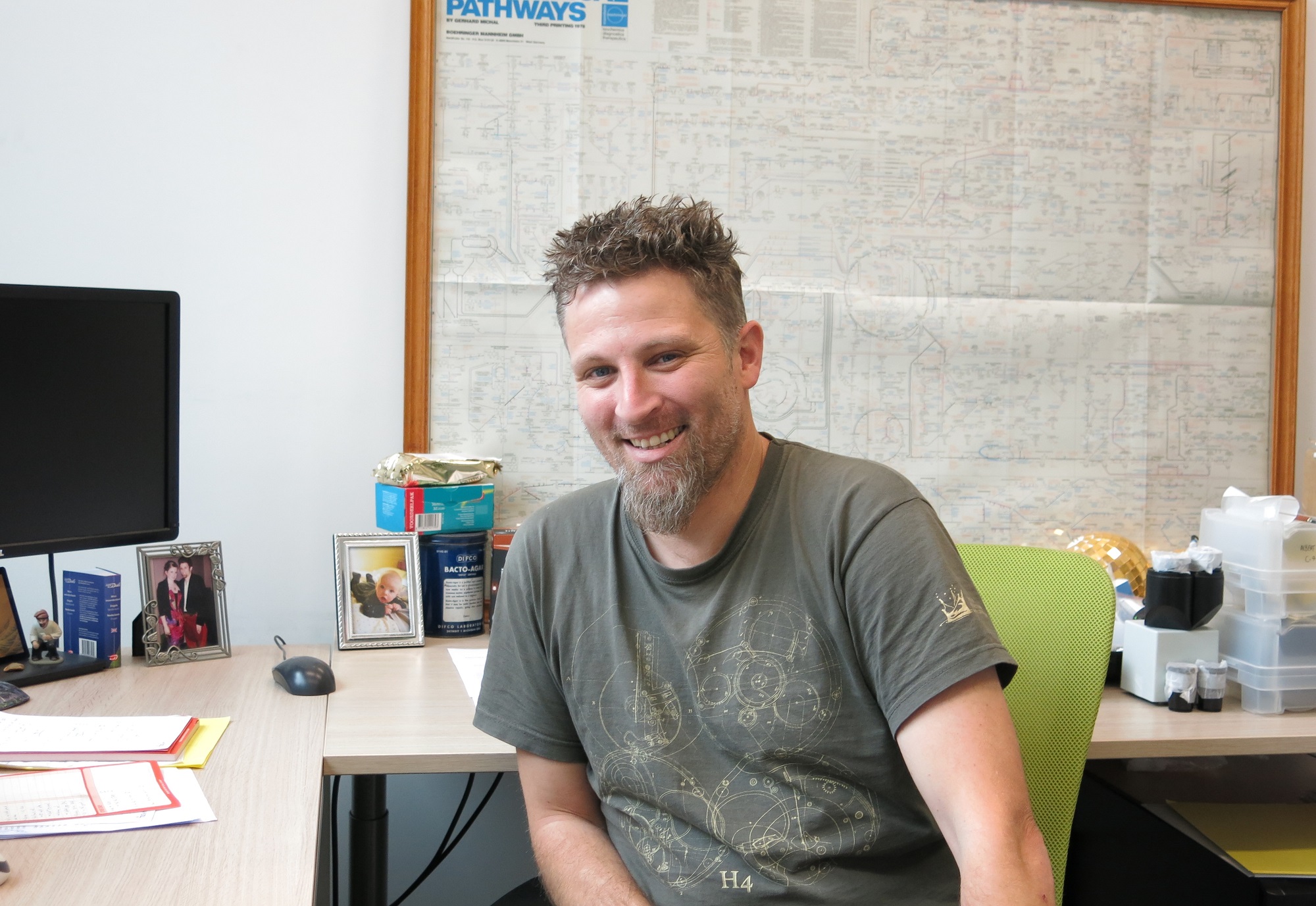Imagine using a fruit enzyme to organically engineer a solar cell that can become a window. Dr Duncan McMillan’s team has done it.
‘Assistant Professor Duncan McMillan: “If you can make something accessible to a far wider audience that’s great.” (Photo: Heather Montague)
“When I was building membranes as a postdoc at the University of Leeds in the UK, we were evaporating gold and template stripping it. That means we were able to make atomically flat gold surfaces and build membranes that are nice and flat. Once you start working with surface science you can do other things with it.
I was at a conference on electrochemistry and I met another guy who turned out to be a chemist from the same university in Leeds. He was very interested in silicateins, enzymes that mineralise silicon dioxide to form these beautiful structures you see in sea sponges. He said they were having trouble with enzymes and asked me what I thought as a biochemist. I could tell from the structure that it looked like the enzyme papain from papaya. We looked it up together and found out that there had been a little bit of work done with titanium dioxide, and silicateins are very similar to titanium dioxide in terms of chemistry. From that conversation, we decided to apply for a small grant and just try some things.
The idea I came up with was trying to stick the enzyme on a surface. If you mineralise something, you should be able to see it on the surface and it worked the first time, I tried it. We were able to mineralise titanium dioxide at room temperature on a surface. We were actually sticking it to a chip that was made of silicon dioxide in the first place. We discovered that by mineralising titanium dioxide, the enzyme could stick to the titanium dioxide that it had just mineralised and then we could stack it like a sandwich. That means that every time you stack it you double the surface area. We were able to stack it 50 layers thick. The process was as simple as dipping a piece of glass into a solution of enzyme and then dipping it straight into titanium lactate and it would mineralise within 20 minutes.
When I came to TU Delft, I finished the work that I had started in Leeds. I basically inhibited the active side of the enzyme to prove that the enzyme was actually doing it and not just some weird effect. That was a key experiment which led to the initial work being published. Then I heard a new colleague, Dr Stephan Eijt of the Reactor Institute Delft, speaking about positron annihilation spectroscopy on titanium dioxide. For me, being a biologist, that sounded fairly magical. He was very interested in what we were doing and we decided to collaborate.
We started mineralising the titanium on the surface and we gave it to him to analyse. Lo and behold we found that it wasn’t actually a solid surface of titanium that we were making, but it was really porous. The deeper we would go we could still access the deep layers from the top. After that, we decided to start putting some organic fluorophores with it and in this case, we used some juice from pomegranates to capture photons from the sun. This helped us realise the production of a fully organically engineered solar cell.
‘The beauty of it is that we’re using an enzyme to produce it’
The idea is that because it’s optically transparent, we can turn it into windows to essentially head towards the production of solar windows. But this is a DSSC, or dye-sensitised solar cell. They’re not typically the most efficient things in the world but the beauty of it is that we’re using an enzyme to produce it. Usually, the process requires a very high temperature, hundreds of degrees, but we’re doing this at room temperature. So you automatically have a massive cost savings in terms of manufacturing.
One thing I think that’s really a big problem, as we get more efficient with solar cell technology, is how accessible it is to the public. We need something cheap and accessible to the wider public that you can cure in an oven and make it last. With this process we can do that. Efficiency and dye stability is something we can work on over time but if you can make something accessible to a far wider audience that’s great.
We’re starting to work with Dr Harry Martin and the Crown Research Institute ‘Plant and Food’ and a company, Zespri, in New Zealand because they’ve got kiwifruit, which happens to have an enzyme related to papain from papaya. The idea is to use waste fruit to build technologies. The entire aim is to make an accessible technology that we can synthesise in an environment where you don’t need special equipment and that can generate energy in a clean, green way and with limited waste. If you take a standard solar panel, the recycling aspect is challenging. If you take what we’re doing, it’s not a disposable anymore, it’s a renewable.”
Want to be featured in Humans of TU Delft? Or do you know someone with a good story to tell? Send us an e-mail at humansoftudelft@gmail.com
Heather Montague / Freelance writer



Comments are closed.